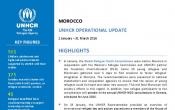Morocco
Operation: Morocco
Location
{"longitude":-7,"latitude":32,"zoom_level":0}
Latest update of camps and office locations 13 Jan 2016. By clicking on the icons on the map, additional information is displayed.
Key Figures
| 2015 end-year results | |
| 4,237 | asylum-seekers registered in 2015, which represented a 125% increase when compared to 2014 |
| 1,235 | asylum-seekers were identified by partners in northern Morocco and referred to UNHCR for registration as safe alternative to perilous illegal onward movement |
| 885 | vulnerable refugee households deemed vulnerable (23% per cent of the refugee population) were assisted with monthly financial assistance |
| 40% | of the refugee population were assisted with medical referrals/medical care |
| 85% | of needs for primary education were met |
| 83 | refugee households received assistance to undertake income- generating projects |
| 100 | cases were submitted for resettlement |
Latest Updates
People of Concern
80%
Increase in
2015
2015
| 2015 | 5,473 |
| 2014 | 3,048 |
| 2013 | 4,973 |

[["Refugees",3908],["Asylum-seekers",1565]]
Loading ...
Budgets and Expenditure for Morocco
< Back
2015
{"categories":[2012,2013,2014,2015,2016],"budget":[2.76386772,3.26822619,3.57777971,4.166918764,5.88072555],"expenditure":[2.19370673,2.18764167,2.81881231,3.06590613,null]}
{"categories":[2012,2013,2014,2015,2016],"p1":[2.76386772,3.26822619,3.57777971,4.166918764,5.88072555],"p2":[null,null,null,null,null],"p3":[null,null,null,null,null],"p4":[null,null,null,null,null]}
{"categories":[2012,2013,2014,2015,2016],"p1":[2.19370673,2.18764167,2.81881231,3.06590613,null],"p2":[null,null,null,null,null],"p3":[null,null,null,null,null],"p4":[null,null,null,null,null]}
Loading ...
CHOOSE A YEAR
- 2015
Working environment
- Refugees in Morocco were from 36 countries, primarily the Syrian Arab Republic.
- A growing number of people in need of international protection found refuge in Morocco in 2015. The establishment of a new asylum system has been gradual, and UNHCR’s assistance for refugees remained critical.
- The submission to Parliament of the draft asylum bill was postponed, and this further delayed the creation of a national asylum body. Meanwhile, the status of UNHCR-registered refugees was regularized by the inter-ministerial ad hoc Commission on Regularization. All cases were recognized by the Commission, and refugee cards were issued to refugees, with the exception of Syrians. As recognized refugees, the latter were protected from refoulement and had access to essential public services. However, without legal status or residency, Syrian refugees could not be legally employed.
Population trends
- In the course of 2015, the number of UNHCR-registered refugees increased by over 200 per cent, to some 3,900 individuals, the majority of which were Syrian.
- The number of localities where refugees settled in Morocco rose to 42, mainly in main cities such as Casablanca, Rabat, Oujda, Témara, Kenitra, Tanger, Meknès, Salé, Fès, Tétouan and Marrakech.
- The percentage of registered-refugees who departed spontaneously from Morocco to seek asylum elsewhere decreased.
- Trends indicated that while still a transit country for migrants and refugees, Morocco was also becoming a host country for refugees.
Achievements and impact
- UNHCR continued to focus on the handover of the refugee status determination procedure to the authorities, notably through capacity building, pending the submission of the asylum bill to Parliament and transition towards a legal and institutional national asylum framework.
- Under its mandate, UNHCR also continued to process individual asylum claims for persons of all nationalities, except for Syrian and Yemeni refugees who were recognized as prima facie refugees.
- UNHCR registered an increasing number of asylum-seekers in 2015.
Unmet needs
- Due to financial constraints, UNHCR had to further prioritize financial assistance to households deemed vulnerable. Support for all patients with chronic diseases could not be sustained throughout the year. Despite the growing number of chronically ill refugees, which increased eightfold in 2015, UNHCR had to prioritize life-saving interventions.

